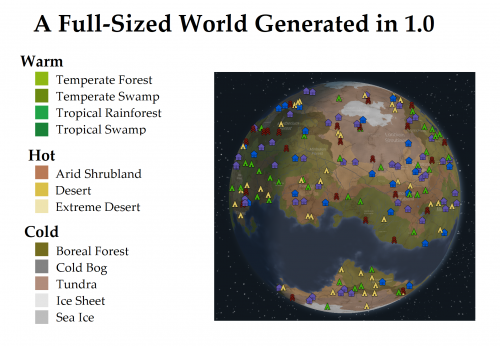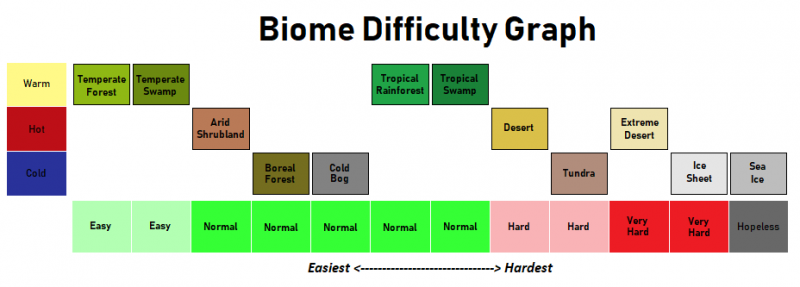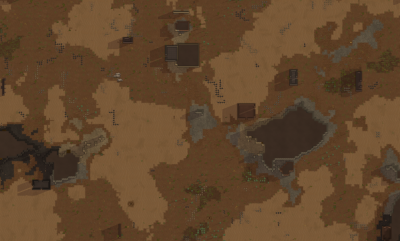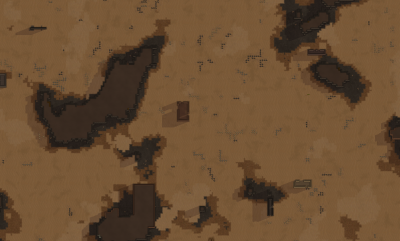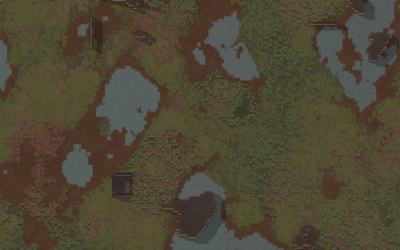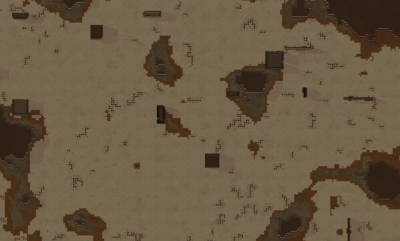Difference between revisions of "Biomes"
m (Typo.) |
(Fixing various biomes descriptions.) |
||
| Line 22: | Line 22: | ||
</onlyinclude> | </onlyinclude> | ||
==Warm Biomes== | ==Warm Biomes== | ||
| − | These biomes are rich in flora and fauna, and also have a slightly elevated rate of disease. They generally have year-round growing periods, or longer growing periods at the very least. | + | These biomes are rich in flora and fauna, and also have a slightly elevated rate of disease. They generally have year-round growing periods, or longer growing periods at the very least. Traveling speed is usually average but is slower in more dense forests and in cold seasons if they have one. |
| − | ===Temperate | + | ===Temperate Forest=== |
A friendly biome dominated by forests of deciduous trees interspersed with fertile clearings. Many species of animals move around in the trees and on the plains. | A friendly biome dominated by forests of deciduous trees interspersed with fertile clearings. Many species of animals move around in the trees and on the plains. | ||
====Season, Temperature and Plant Growth Cycle==== | ====Season, Temperature and Plant Growth Cycle==== | ||
* Season: Varies considerably, can be year-round or just 11th of Spring - 1st of Fall. | * Season: Varies considerably, can be year-round or just 11th of Spring - 1st of Fall. | ||
* Temperature: An annual average of just above {{Temperature|0}} is possible, up to an average of {{Temperature|20}} in warmer climates. | * Temperature: An annual average of just above {{Temperature|0}} is possible, up to an average of {{Temperature|20}} in warmer climates. | ||
| − | * Plant Growth Cycle: Depending on location, plant growth may | + | * Plant Growth Cycle: Depending on location, plant growth may stop during winter. |
[[File:TemperateForest.png|400px|Temperate Forest Small Hills]] | [[File:TemperateForest.png|400px|Temperate Forest Small Hills]] | ||
| − | |||
| − | |||
| − | |||
| − | |||
| − | |||
| − | |||
| − | |||
| − | |||
| − | |||
---- | ---- | ||
===Temperate Swamp=== | ===Temperate Swamp=== | ||
| − | Temperate swamps have | + | A more wet version of the Temperate Forest, like in all swamps diseases are more common, the marshy soil greatly restricts building and the terrain is really slow to travel, but they also have more fertile soil. |
| − | |||
====Season, Temperature and Plant Growth Cycle==== | ====Season, Temperature and Plant Growth Cycle==== | ||
* Season: Varies considerably, can be year-round or just 11th of Spring - 1st of Fall. | * Season: Varies considerably, can be year-round or just 11th of Spring - 1st of Fall. | ||
* Temperature: An annual average of just above {{Temperature|0}} is possible, up to an average of {{Temperature|20}} in warmer climates. | * Temperature: An annual average of just above {{Temperature|0}} is possible, up to an average of {{Temperature|20}} in warmer climates. | ||
| − | * Plant Growth Cycle: Depending on location, plant growth may | + | * Plant Growth Cycle: Depending on location, plant growth may stop during winter. |
| + | ---- | ||
| + | |||
| + | ===Tropical Rainforest=== | ||
| + | A thick, moist jungle. Dense overgrowth and aggressive wildlife make construction and survival difficult. Tropical Rainforests are also notorious for sweltering summers and diabolical diseases, including [[Disease#Sleeping_Sickness|Sleeping Sickness]]: a slow-progressing, long-lasting disease that is exclusive to the tropics. | ||
| + | ====Season, Temperature and Plant Growth Cycle==== | ||
| + | * Season: Year-round. | ||
| + | * Temperature: Averages {{Temperature|20}} to {{Temperature|30}} over the course of the whole year. | ||
| + | * Plant Growth Cycle: Plants thrive throughout the year. | ||
| + | |||
| + | [[File:TropicalRainforest.png|400px|Tropical Rainforest Large Hills]] | ||
---- | ---- | ||
===Tropical Swamp=== | ===Tropical Swamp=== | ||
| − | Tropical swamps are | + | A more wet version of the Tropical Rainforest, like in all swamps diseases are more common, the marshy soil greatly restricts building and the terrain is really slow to travel, but they also have more fertile soil. |
| − | + | Diseases are more constant here than any other biome, making it difficult to live in unless you have enough skilled doctors. | |
====Season, Temperature and Plant Growth Cycle==== | ====Season, Temperature and Plant Growth Cycle==== | ||
* Season: Year-round. | * Season: Year-round. | ||
| − | * Temperature: Averages {{Temperature|20}} to {{Temperature|30}} over the course of the whole year | + | * Temperature: Averages {{Temperature|20}} to {{Temperature|30}} over the course of the whole year. |
| − | * Plant Growth Cycle: Plants thrive throughout the year | + | * Plant Growth Cycle: Plants thrive throughout the year. |
==Hot Biomes== | ==Hot Biomes== | ||
| − | These biomes become progressively dry as they become more arid. Moderate amount of flora and fauna, which drops off as you pick a more extreme biome. Mostly year-round growing periods, | + | These biomes become progressively dry as they become more arid. Moderate amount of flora and fauna, which drops off as you pick a more extreme biome. Mostly year-round growing periods, except in cold deserts. Traveling in those biomes is faster than any other biomes. |
===Arid shrubland=== | ===Arid shrubland=== | ||
| Line 69: | Line 69: | ||
====Season, Temperature and Plant Growth Cycle==== | ====Season, Temperature and Plant Growth Cycle==== | ||
* Season: Year-round. | * Season: Year-round. | ||
| − | * Temperature: Ranges from an annual average of {{Temperature|20}} to over {{Temperature|30}}. | + | * Temperature: Ranges from an annual average of {{Temperature|20}} to over {{Temperature|30}}. |
| − | * Plant Growth Cycle: | + | * Plant Growth Cycle: Plants thrive throughout the year. |
[[File:AridShrubland.png|400px|Arid Shrubland Small Hills]] | [[File:AridShrubland.png|400px|Arid Shrubland Small Hills]] | ||
---- | ---- | ||
===Desert=== | ===Desert=== | ||
| − | A very dry area which supports little life. There are scattered areas of dirt which crops can be grown on. | + | A very dry area which supports little life. There are scattered areas of dirt which crops can be grown on. Unlike the other arid biomes Deserts can also be cold. |
====Season, Temperature and Plant Growth Cycle==== | ====Season, Temperature and Plant Growth Cycle==== | ||
* Season: Varies considerably. Can be year-round, or 1st of Summer to 11th of Summer. | * Season: Varies considerably. Can be year-round, or 1st of Summer to 11th of Summer. | ||
* Temperature: An annual average of over {{Temperature|20}} is possible. In colder climates this can plummet to an annual average just above {{Temperature|0}}. | * Temperature: An annual average of over {{Temperature|20}} is possible. In colder climates this can plummet to an annual average just above {{Temperature|0}}. | ||
| − | * Plant Growth Cycle: | + | * Plant Growth Cycle: Depending on location, plant growth may stop during winter. |
[[File:Desert.png|400px|Desert Mountainous]] | [[File:Desert.png|400px|Desert Mountainous]] | ||
---- | ---- | ||
===Extreme desert=== | ===Extreme desert=== | ||
| − | An extremely hot and dry area which is hostile to most life. | + | An extremely hot and dry area which is hostile to most life. Fertile land is nonexistent and wildlife is extremely scarce. Even cactus are hard to find. Its warm enough for growing plants outdoors but it has to be done in stony patches around hills and mountains. [[Potatoes]] grows better in stony soil, but [[Berries|berries]] can also be a good idea since there is no wood for cooking. |
====Season, Temperature and Plant Growth Cycle==== | ====Season, Temperature and Plant Growth Cycle==== | ||
| − | *Season: | + | *Season: Year-round. |
*Temperature: Annual averages generally from {{Temperature|20}} to {{Temperature|30}}. | *Temperature: Annual averages generally from {{Temperature|20}} to {{Temperature|30}}. | ||
| − | *Plant Growth Cycle: | + | *Plant Growth Cycle: Plants thrive throughout the year. |
[[File:ExtremeDesert.png|400px|Extreme Desert Flat]] | [[File:ExtremeDesert.png|400px|Extreme Desert Flat]] | ||
==Cold Biomes== | ==Cold Biomes== | ||
| − | These biomes become progressively colder and hostile as they become more intense. Flora and fauna becomes more scarce as you pick a more extreme biome. | + | These biomes become progressively colder and hostile as they become more intense. Flora and fauna becomes more scarce as you pick a more extreme biome. Mostly seasonal growing periods but may go down to no growing period in more extreme biomes. Traveling in those biomes is very slow on winter which can be very long. |
| − | ===Boreal | + | ===Boreal Forest=== |
| − | Northern forests of coniferous trees. Despite the harsh winters, boreal forests sustain a diverse population of small and large animals, and somewhat dense flora. You can find many raspberry bushes scattered around, and also a few large bogs | + | Northern forests of coniferous trees. Despite the harsh winters, boreal forests sustain a diverse population of small and large animals, and somewhat dense flora. You can find many raspberry bushes scattered around, and also a few large bogs. |
====Season, Temperature and Plant Growth Cycle==== | ====Season, Temperature and Plant Growth Cycle==== | ||
| − | * Season: Anywhere from 6th of Spring - 6th of Fall | + | * Season: Anywhere from 6th of Spring - 6th of Fall. Generally 11th of Spring - 1st of Fall or 1st of Summer - 11th of Summer. |
* Temperature: from {{Temperature|20}} to {{Temperature|10}} in summer, from {{Temperature|-10}} to {{Temperature|-30}} in winter | * Temperature: from {{Temperature|20}} to {{Temperature|10}} in summer, from {{Temperature|-10}} to {{Temperature|-30}} in winter | ||
| − | * Plant Growth Cycle: | + | * Plant Growth Cycle: Plant growth usually is restricted to summer but may also happen in spring and fall. |
[[File:BorealForest.png|400px|Boreal Forest Flat]] | [[File:BorealForest.png|400px|Boreal Forest Flat]] | ||
---- | ---- | ||
| + | |||
| + | ===Cold Bog=== | ||
| + | |||
| + | A more wet version of the Boreal Forest, like in all swamps diseases are more common, the marshy soil greatly restricts building and the terrain is really slow to travel, but they also have more fertile soil. | ||
| + | ====Season, Temperature and Plant Growth Cycle==== | ||
| + | * Season: Anywhere from 6th of Spring - 6th of Fall. Generally 11th of Spring - 1st of Fall or 1st of Summer - 11th of Summer. | ||
| + | * Temperature: from {{Temperature|20}} to {{Temperature|10}} in summer, from {{Temperature|-10}} to {{Temperature|-30}} in winter | ||
| + | * Plant Growth Cycle: Plant growth usually is restricted to summer but may also happen in spring and fall. | ||
| + | |||
| + | [[File:Cold Bog.png|400px]] | ||
| + | ---- | ||
| + | |||
===Tundra=== | ===Tundra=== | ||
These mostly-frozen plains bear almost no trees and little vegetation. There are a few small animals interspersed with large herds of migratory grazers and their predators. Growing periods are generally very short or non-existent. This makes Tundra a challenging biome to survive on. | These mostly-frozen plains bear almost no trees and little vegetation. There are a few small animals interspersed with large herds of migratory grazers and their predators. Growing periods are generally very short or non-existent. This makes Tundra a challenging biome to survive on. | ||
| Line 110: | Line 122: | ||
* Season: usually 1st of Summer - 11th of Summer or Never. | * Season: usually 1st of Summer - 11th of Summer or Never. | ||
* Temperature: Taken as an average through the year, can be as mild as {{Temperature|0}} or as severe as {{Temperature|-20}}. | * Temperature: Taken as an average through the year, can be as mild as {{Temperature|0}} or as severe as {{Temperature|-20}}. | ||
| − | * Plant Growth Cycle: | + | * Plant Growth Cycle: Plant growth is restricted to summer or nonexistent. |
[[File:Tundra.png|400px|Tundra Small Hills]] | [[File:Tundra.png|400px|Tundra Small Hills]] | ||
| − | |||
| − | |||
| − | |||
| − | |||
| − | |||
| − | |||
| − | |||
---- | ---- | ||
===Ice sheet=== | ===Ice sheet=== | ||
| − | The surface is covered with sheets of ice which can be kilometers thick. There is no access to soil | + | The surface is covered with sheets of ice which can be kilometers thick. There is no access to soil so there are no plants. The only animals seen here are migrating to somewhere else. Surviving is very difficult because [[Hydroponics basin|hydroponics]] and stony patches around hills and mountains can be used to growing but need they to be heated indoors with sun lamps or roof openings. [[Potatoes]] grows better in stony soil. Geothermal vents can be used for free heating. |
| − | |||
====Season, Temperature and Plant Growth Cycle==== | ====Season, Temperature and Plant Growth Cycle==== | ||
* Season: Never | * Season: Never | ||
* Temperature: from {{Temperature|1}} to {{Temperature|-40}} in summer, from {{Temperature|-40}} to {{Temperature|-120}} in winter | * Temperature: from {{Temperature|1}} to {{Temperature|-40}} in summer, from {{Temperature|-40}} to {{Temperature|-120}} in winter | ||
| − | * Plant Growth Cycle: | + | * Plant Growth Cycle: Never. |
[[File:IceSheet.png|400px|Ice Sheet Large Hills]] | [[File:IceSheet.png|400px|Ice Sheet Large Hills]] | ||
---- | ---- | ||
===Sea Ice=== | ===Sea Ice=== | ||
| − | This is where the sea has frozen over to the point where a thick ice sheet is formed, theoretically making it habitable. For those that thought Ice Sheet wasn't difficult enough: no flora, fauna or rocks - everything must be done via trading, or cannibalism, until you can eventually get hydroponics. Moisture pumps allow for turning the few shallow pools into patches of | + | This is where the sea has frozen over to the point where a thick ice sheet is formed, theoretically making it habitable. For those that thought Ice Sheet wasn't difficult enough: no flora, fauna or rocks - everything must be done via trading, or cannibalism, until you can eventually get [[Hydroponics basin|hydroponics]]. Later [[Moisture pump|moisture pumps]] allow for turning the few shallow pools into patches of soil, allowing you to build greenhouses over them. It is worth mentioning that Sea Ice even though possible was not designed at all to allow colony building, only to allow traveling in the area. |
====Season, Temperature and Plant Growth Cycle==== | ====Season, Temperature and Plant Growth Cycle==== | ||
* Season: Never | * Season: Never | ||
| − | * Temperature: | + | * Temperature: Sub-zero at all times except mid-day in the peak of summer. |
| − | * Plant Growth Cycle: | + | * Plant Growth Cycle: Never. |
---- | ---- | ||
Revision as of 13:05, 10 August 2018
|
Biomes are types of area on a planet, characterized by their terrain properties, climate, flora and fauna, diseases and special challenges. Each world tile has one particular biome.
Oceans and lakes appears as world tiles but are not playable biomes.
There are twelve playable biomes types in RimWorld, divided into three categories: Warm, Hot and Cold.
The following table is a simple summary of the biomes by difficulty, overall cold biomes are more challenging than their hot counterparts. You can use this table to help decide which biome best suits your experience or playstyle:
Warm Biomes
These biomes are rich in flora and fauna, and also have a slightly elevated rate of disease. They generally have year-round growing periods, or longer growing periods at the very least. Traveling speed is usually average but is slower in more dense forests and in cold seasons if they have one.
Temperate Forest
A friendly biome dominated by forests of deciduous trees interspersed with fertile clearings. Many species of animals move around in the trees and on the plains.
Season, Temperature and Plant Growth Cycle
- Season: Varies considerably, can be year-round or just 11th of Spring - 1st of Fall.
- Temperature: An annual average of just above 0 °C (32 °F) is possible, up to an average of 20 °C (68 °F) in warmer climates.
- Plant Growth Cycle: Depending on location, plant growth may stop during winter.
Temperate Swamp
A more wet version of the Temperate Forest, like in all swamps diseases are more common, the marshy soil greatly restricts building and the terrain is really slow to travel, but they also have more fertile soil.
Season, Temperature and Plant Growth Cycle
- Season: Varies considerably, can be year-round or just 11th of Spring - 1st of Fall.
- Temperature: An annual average of just above 0 °C (32 °F) is possible, up to an average of 20 °C (68 °F) in warmer climates.
- Plant Growth Cycle: Depending on location, plant growth may stop during winter.
Tropical Rainforest
A thick, moist jungle. Dense overgrowth and aggressive wildlife make construction and survival difficult. Tropical Rainforests are also notorious for sweltering summers and diabolical diseases, including Sleeping Sickness: a slow-progressing, long-lasting disease that is exclusive to the tropics.
Season, Temperature and Plant Growth Cycle
- Season: Year-round.
- Temperature: Averages 20 °C (68 °F) to 30 °C (86 °F) over the course of the whole year.
- Plant Growth Cycle: Plants thrive throughout the year.
Tropical Swamp
A more wet version of the Tropical Rainforest, like in all swamps diseases are more common, the marshy soil greatly restricts building and the terrain is really slow to travel, but they also have more fertile soil.
Diseases are more constant here than any other biome, making it difficult to live in unless you have enough skilled doctors.
Season, Temperature and Plant Growth Cycle
- Season: Year-round.
- Temperature: Averages 20 °C (68 °F) to 30 °C (86 °F) over the course of the whole year.
- Plant Growth Cycle: Plants thrive throughout the year.
Hot Biomes
These biomes become progressively dry as they become more arid. Moderate amount of flora and fauna, which drops off as you pick a more extreme biome. Mostly year-round growing periods, except in cold deserts. Traveling in those biomes is faster than any other biomes.
Arid shrubland
A dry region, but not dry enough to become a true desert. Open plains with grasses and bushes give way to scattered groves of trees. Plants are hardy and there is a moderate density of animals.
Season, Temperature and Plant Growth Cycle
- Season: Year-round.
- Temperature: Ranges from an annual average of 20 °C (68 °F) to over 30 °C (86 °F).
- Plant Growth Cycle: Plants thrive throughout the year.
Desert
A very dry area which supports little life. There are scattered areas of dirt which crops can be grown on. Unlike the other arid biomes Deserts can also be cold.
Season, Temperature and Plant Growth Cycle
- Season: Varies considerably. Can be year-round, or 1st of Summer to 11th of Summer.
- Temperature: An annual average of over 20 °C (68 °F) is possible. In colder climates this can plummet to an annual average just above 0 °C (32 °F).
- Plant Growth Cycle: Depending on location, plant growth may stop during winter.
Extreme desert
An extremely hot and dry area which is hostile to most life. Fertile land is nonexistent and wildlife is extremely scarce. Even cactus are hard to find. Its warm enough for growing plants outdoors but it has to be done in stony patches around hills and mountains. Potatoes grows better in stony soil, but berries can also be a good idea since there is no wood for cooking.
Season, Temperature and Plant Growth Cycle
- Season: Year-round.
- Temperature: Annual averages generally from 20 °C (68 °F) to 30 °C (86 °F).
- Plant Growth Cycle: Plants thrive throughout the year.
Cold Biomes
These biomes become progressively colder and hostile as they become more intense. Flora and fauna becomes more scarce as you pick a more extreme biome. Mostly seasonal growing periods but may go down to no growing period in more extreme biomes. Traveling in those biomes is very slow on winter which can be very long.
Boreal Forest
Northern forests of coniferous trees. Despite the harsh winters, boreal forests sustain a diverse population of small and large animals, and somewhat dense flora. You can find many raspberry bushes scattered around, and also a few large bogs.
Season, Temperature and Plant Growth Cycle
- Season: Anywhere from 6th of Spring - 6th of Fall. Generally 11th of Spring - 1st of Fall or 1st of Summer - 11th of Summer.
- Temperature: from 20 °C (68 °F) to 10 °C (50 °F) in summer, from -10 °C (14 °F) to -30 °C (-22 °F) in winter
- Plant Growth Cycle: Plant growth usually is restricted to summer but may also happen in spring and fall.
Cold Bog
A more wet version of the Boreal Forest, like in all swamps diseases are more common, the marshy soil greatly restricts building and the terrain is really slow to travel, but they also have more fertile soil.
Season, Temperature and Plant Growth Cycle
- Season: Anywhere from 6th of Spring - 6th of Fall. Generally 11th of Spring - 1st of Fall or 1st of Summer - 11th of Summer.
- Temperature: from 20 °C (68 °F) to 10 °C (50 °F) in summer, from -10 °C (14 °F) to -30 °C (-22 °F) in winter
- Plant Growth Cycle: Plant growth usually is restricted to summer but may also happen in spring and fall.
Tundra
These mostly-frozen plains bear almost no trees and little vegetation. There are a few small animals interspersed with large herds of migratory grazers and their predators. Growing periods are generally very short or non-existent. This makes Tundra a challenging biome to survive on.
Season, Temperature and Plant Growth Cycle
- Season: usually 1st of Summer - 11th of Summer or Never.
- Temperature: Taken as an average through the year, can be as mild as 0 °C (32 °F) or as severe as -20 °C (-4 °F).
- Plant Growth Cycle: Plant growth is restricted to summer or nonexistent.
Ice sheet
The surface is covered with sheets of ice which can be kilometers thick. There is no access to soil so there are no plants. The only animals seen here are migrating to somewhere else. Surviving is very difficult because hydroponics and stony patches around hills and mountains can be used to growing but need they to be heated indoors with sun lamps or roof openings. Potatoes grows better in stony soil. Geothermal vents can be used for free heating.
Season, Temperature and Plant Growth Cycle
- Season: Never
- Temperature: from 1 °C (33.8 °F) to -40 °C (-40 °F) in summer, from -40 °C (-40 °F) to -120 °C (-184 °F) in winter
- Plant Growth Cycle: Never.
Sea Ice
This is where the sea has frozen over to the point where a thick ice sheet is formed, theoretically making it habitable. For those that thought Ice Sheet wasn't difficult enough: no flora, fauna or rocks - everything must be done via trading, or cannibalism, until you can eventually get hydroponics. Later moisture pumps allow for turning the few shallow pools into patches of soil, allowing you to build greenhouses over them. It is worth mentioning that Sea Ice even though possible was not designed at all to allow colony building, only to allow traveling in the area.
Season, Temperature and Plant Growth Cycle
- Season: Never
- Temperature: Sub-zero at all times except mid-day in the peak of summer.
- Plant Growth Cycle: Never.
Wild Inhabitants
Flora
| Biome | Agave | Birch tree | Bush | Cecropia tree | Dandelions | Grass | Moss | Oak tree | Pincushion cactus | Pine tree | Poplar tree | Raspberry bush | Saguaro cactus | Tall grass | Wild Healroot |
| Arid Shrubland | ✓ | ✗ | ✓ | ✗ | ✓ | ✗ | ✓ | ✓ | ✗ | ✓ | ✓ | ✓ | ✓ | ✗ | ✗ |
| Boreal Forest | ✗ | ✓ | ✓ | ✗ | ✗ | ✓ | ✗ | ✗ | ✓ | ✓ | ✓ | ✗ | ✗ | ✗ | ✓ |
| Desert | ✓ | ✗ | ✓ | ✗ | ✓ | ✗ | ✗ | ✓ | ✗ | ✓ | ✓ | ✗ | ✓ | ✗ | ✗ |
| Temperate Forest | ✗ | ✗ | ✓ | ✗ | ✓ | ✓ | ✗ | ✓ | ✗ | ✓ | ✓ | ✓ | ✗ | ✗ | ✓ |
| Tropical Rainforest | ✗ | ✗ | ✓ | ✓ | ✓ | ✗ | ✓ | ✗ | ✗ | ✗ | ✗ | ✓ | ✗ | ✓ | ✗ |
| Tundra | ✗ | ✓ | ✓ | ✗ | ✓ | ✓ | ✗ | ✗ | ✓ | ✗ | ✓ | ✓ | ✗ | ✗ | ✓ |
Fauna
| Biome | Alpaca | Arctic fox | Arctic wolf | Boar | Boomalope | Boomrat | Capybara | Caribou | Cassowary | Chicken | Chinchilla | Cobra | Cougar | Cow | Deer | Dromedary | Elephant |
| Arid Shrubland | ✗ | ✗ | ✗ | ✗ | ✗ | ✗ | ✗ | ✗ | ✗ | ✗ | ✗ | ✗ | ✗ | ✗ | ✗ | ✗ | ✗ |
| Boreal Forest | ✗ | ✗ | ✗ | ✗ | ✗ | ✗ | ✗ | ✗ | ✗ | ✗ | ✗ | ✗ | ✗ | ✗ | ✗ | ✗ | ✗ |
| Desert | ✗ | ✗ | ✗ | ✗ | ✗ | ✗ | ✗ | ✗ | ✗ | ✗ | ✗ | ✗ | ✗ | ✗ | ✗ | ✗ | ✗ |
| Extreme Desert | ✗ | ✗ | ✗ | ✗ | ✗ | ✗ | ✗ | ✗ | ✗ | ✗ | ✗ | ✗ | ✗ | ✗ | ✗ | ✗ | ✗ |
| Ice Sheet | ✗ | ✗ | ✗ | ✗ | ✗ | ✗ | ✗ | ✗ | ✗ | ✗ | ✗ | ✗ | ✗ | ✗ | ✗ | ✗ | ✗ |
| Sea Ice | ✗ | ✗ | ✗ | ✗ | ✗ | ✗ | ✗ | ✗ | ✗ | ✗ | ✗ | ✗ | ✗ | ✗ | ✗ | ✗ | ✗ |
| Temperate Forest | ✗ | ✗ | ✗ | ✗ | ✗ | ✗ | ✗ | ✗ | ✗ | ✗ | ✗ | ✗ | ✗ | ✗ | ✗ | ✗ | ✗ |
| Tropical Rainforest | ✗ | ✗ | ✗ | ✗ | ✗ | ✗ | ✗ | ✗ | ✗ | ✗ | ✗ | ✗ | ✗ | ✗ | ✗ | ✗ | ✗ |
| Tundra | ✗ | ✗ | ✗ | ✗ | ✗ | ✗ | ✗ | ✗ | ✗ | ✗ | ✗ | ✗ | ✗ | ✗ | ✗ | ✗ | ✗ |
| Biome | Elk | Emu | Fennec fox | Gazelle | Grizzly bear | Hare | Husky | Ibex | Iguana | Labrador retriever | Lynx | Megascarab | Megasloth | Monkey | Muffalo | Ostrich |
| Arid Shrubland | ✗ | ✗ | ✗ | ✗ | ✗ | ✗ | ✗ | ✗ | ✗ | ✗ | ✗ | ✗ | ✗ | ✗ | ✗ | ✗ |
| Boreal Forest | ✗ | ✗ | ✗ | ✗ | ✗ | ✗ | ✗ | ✗ | ✗ | ✗ | ✗ | ✗ | ✗ | ✗ | ✗ | ✗ |
| Desert | ✗ | ✗ | ✗ | ✗ | ✗ | ✗ | ✗ | ✗ | ✗ | ✗ | ✗ | ✗ | ✗ | ✗ | ✗ | ✗ |
| Extreme Desert | ✗ | ✗ | ✗ | ✗ | ✗ | ✗ | ✗ | ✗ | ✗ | ✗ | ✗ | ✗ | ✗ | ✗ | ✗ | ✗ |
| Ice Sheet | ✗ | ✗ | ✗ | ✗ | ✗ | ✗ | ✗ | ✗ | ✗ | ✗ | ✗ | ✗ | ✗ | ✗ | ✗ | ✗ |
| Sea Ice | ✗ | ✗ | ✗ | ✗ | ✗ | ✗ | ✗ | ✗ | ✗ | ✗ | ✗ | ✗ | ✗ | ✗ | ✗ | ✗ |
| Temperate Forest | ✗ | ✗ | ✗ | ✗ | ✗ | ✗ | ✗ | ✗ | ✗ | ✗ | ✗ | ✗ | ✗ | ✗ | ✗ | ✗ |
| Tropical Rainforest | ✗ | ✗ | ✗ | ✗ | ✗ | ✗ | ✗ | ✗ | ✗ | ✗ | ✗ | ✗ | ✗ | ✗ | ✗ | ✗ |
| Tundra | ✗ | ✗ | ✗ | ✗ | ✗ | ✗ | ✗ | ✗ | ✗ | ✗ | ✗ | ✗ | ✗ | ✗ | ✗ | ✗ |
| Biome | Panther | Pig | Polar bear | Raccoon | Rat | Red fox | Rhinoceros | Snowhare | Squirrel | Thrumbo | Timber wolf | Tortoise | Turkey | Warg | Yorkshire terrier |
| Arid Shrubland | ✗ | ✗ | ✗ | ✗ | ✗ | ✗ | ✗ | ✗ | ✗ | ✗ | ✗ | ✗ | ✗ | ✗ | ✗ |
| Boreal Forest | ✗ | ✗ | ✗ | ✗ | ✗ | ✗ | ✗ | ✗ | ✗ | ✗ | ✗ | ✗ | ✗ | ✗ | ✗ |
| Desert | ✗ | ✗ | ✗ | ✗ | ✗ | ✗ | ✗ | ✗ | ✗ | ✗ | ✗ | ✗ | ✗ | ✗ | ✗ |
| Extreme Desert | ✗ | ✗ | ✗ | ✗ | ✗ | ✗ | ✗ | ✗ | ✗ | ✗ | ✗ | ✗ | ✗ | ✗ | ✗ |
| Ice Sheet | ✗ | ✗ | ✗ | ✗ | ✗ | ✗ | ✗ | ✗ | ✗ | ✗ | ✗ | ✗ | ✗ | ✗ | ✗ |
| Sea Ice | ✗ | ✗ | ✗ | ✗ | ✗ | ✗ | ✗ | ✗ | ✗ | ✗ | ✗ | ✗ | ✗ | ✗ | ✗ |
| Temperate Forest | ✗ | ✗ | ✗ | ✗ | ✗ | ✗ | ✗ | ✗ | ✗ | ✗ | ✗ | ✗ | ✗ | ✗ | ✗ |
| Tropical Rainforest | ✗ | ✗ | ✗ | ✗ | ✗ | ✗ | ✗ | ✗ | ✗ | ✗ | ✗ | ✗ | ✗ | ✗ | ✗ |
| Tundra | ✗ | ✗ | ✗ | ✗ | ✗ | ✗ | ✗ | ✗ | ✗ | ✗ | ✗ | ✗ | ✗ | ✗ | ✗ |
